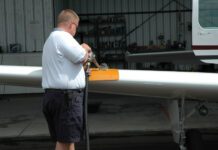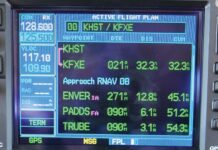by Ron Levy
The advent of GPS has created a two-pronged revolution in aircraft navigation. One is the increased positional awareness GPS brings to the pilot; the other is the ability to fly instrument approaches into small airports that heretofore havent been reachable when the weather is IMC.
Getting into the IFR outback is certainly a major reason to have approach-capable GPS in an airplane and with each passing month, more GPS approaches are coming on line. The FAA plans to publish at least 300 new GPS approaches with WAAS vertical guidance in 2004 and the Mitre Corp. – which provides technical consulting services to the FAA – estimates that about 80 percent of the runways in the U.S. will qualify for a new LPV or LNAV/VNAV approach and nearly two-thirds of them may have minimums down to a 250-foot HAT.
Bottom line: in two or three years, youll be able to get into many outlying airports in weather that would have kept you on the ground in the pre-GPS days. But theres a not-so-obvious can of worms here and this is it: the FAAs air traffic control, specifically radar services, wont necessarily keep up with the GPS revolution, nor will controllers clearly understand what capabilities a certified GPS box gives a pilot. In the end, it will up to pilots to clearly know the rules and in the brave new world of approaches into the boondocks, the most important rule is what cleared for the approach really means.
If youre flying one of the current-generation GPS approaches, there are some peculiarities in how youll be cleared for the approach, depending on your position relative to the fixes and a host of other factors. Well review those issues in this article.
Radar or Not?
One of the most confusing things about approach clearances is knowing whether youre being radar vectored or whether youre expected to fly the approach on your own, using accepted non-radar procedures. Unfortunately, both controllers and pilots tend to have a limited understanding of what non-radar procedures really entail. Why? Because most of us rarely if ever use them. GPS approaches into the remote areas of the country will change that. Youll need to be sharp on non-radar.
In your IFR training and practice, youve probably been in radar contact most of time and most of your approaches have probably been vectors to the final approach course. Indeed, ATC is required to inform you of that fact: Expect vectors to the ILS 10 at Baltimore. The purpose of this phraseology is two-fold: it provides you with ATCs intent in the event of lost comm and it alerts you to the fact that youll be vectored and not expected to use non-radar procedures.
The expect vectors phraseology is so ubiquitous, in fact, that many of us probably dont notice when the controller doesnt say it. And when he doesnt say it, the implication is that the procedure will have to be flown non-radar, which will include navigating to an initial approach fix and possibly flying a procedure turn. Too bad ATC doesnt say this wont be vectors or expect a non-radar procedure.
At some outlying airports, terminal radar coverage is good enough to provide vectors to final, in which case the approach is supposed to be depicted on the controllers video map. But at many more, radar coverage is too poor or the FAA just hasnt gotten around to updating the video maps.
Just to add to the confusion, controllers have the option of using non-radar procedures even when radar is available and in use. Why? Because its sometimes faster and more convenient. ATCs charter is, after all, to safely expedite the flow of traffic.
The Words Matter
The most important thing to remember is that the fundamentals of flying instrument approaches have and will likely remain unchanged, particularly with respect to when you can begin descending using vertical guidance, be it from ILS or GPS LPV. This issue is critical in the discussion that follows and a long forgotten accident makes it so.
On a stormy day in December, 1974, a TWA 727 crashed into a hill near Dulles Airport in Virginia, bringing to tragic light a subject that wasnt well understood by pilots before that accident: When joining an instrument approach, you must not descend below your last assigned altitude until you are established on a published segment of that approach. The TWA 514 accident CVR transcript revealed a discussion – and considerable confusion-between the three crew members on when to descend on the approach. Obviously, they descended prematurely.
This accident spurred the FAA, at the NTSBs behest, to change the controllers manual to add the phrase maintain [altitude] until established to the standard ATC phraseology when clearing aircraft for approaches. This certainly helped clarify approach clearances but it left one potential area of confusion unaddressed. How can a pilot determine when hes being vectored and when hes not being vectored to the final approach course?
Again, its all in the words used by ATC, or in the pilots local knowledge of the area, if hes lucky enough to have it. In a full-up radar environment, you can expect to be vectored to the final approach course and, as noted above, the controller will say as much. If youre vectored, the final approach clearance should sound like this: Bonanza Three Six Delta, youre three miles from COLUM, maintain 2500 feet until established on the final approach course, cleared for the ILS 10 at Baltimore. (In the pre-TWA 514 days, that part about maintain 2500 feet wasnt used.)
At this juncture, its fair to ask what exactly established means. Theres no widely agreed upon definition. The only official definition is the Pilot/Controller Glossary, which says, ESTABLISHED – To be stable or fixed on a route, route segment, altitude, heading, etc. This rather subjective definition doesnt help much in deciding when to start down.
The best practical definition comes from TERPS guru Wally Roberts who, coincidentally, was an investigator on the 514 crash. Roberts argues that one is established when one has passed the fix or point that marks the beginning of the segment being entered, positive course guidance (PCG) indicates on course and continued on course tracking of the PCG is assured.
He further defines on course as flying the indicated centerline of the segment to at least minimum certification standards for instrument pilots, which is less than full deflection outside the final approach fix (FAF) and three-quarters scale deflection inside the FAF. A good working definition of positive course guidance, by the way, includes any approved electronic navigation system such as VOR, ADF or GPS, when receiving properly and being used to track a segment defined on the approach chart.
In determining whether youre established, you should also think about how fast the needle is swinging. If youre close to the station or intercepting at a high crossing angle, you may well be temporarily on course but will see the needle peg to the other side shortly thereafter. Dont start down until the needle is moving slowly enough that youre reasonably certain it will stay within the stated parameters.
The need to be established is critical if youre using GPS. Where once you would join an instrument approach from a small number of specific points, and IFR GPS allows you to join the instrument approach at many points along the way. Which brings us to the next point: non-radar approach clearances.
No Vectors
When radar isnt available – either because its broken or youre just too low to be tracked – vectors wont be, either. In that case, you wont hear the words expect vectors but you should expect to hear from ATC an expect that includes a GPS IAF or published transition of some sort. In the real world, this is often overlooked under non-radar procedures so youre on your own to either query the controller or inform him what youd like to do:
Bonanza Three Six Delta requests the GPS 10 approach via TAYLO transition. Such requests are routinely approved which puts the ball immediately back in your court.
In this example, the approach clearance would sound like this: Bonanza Three Six Delta, cross TAYLO at or above 3000 feet, youre cleared for the GPS 10 approach. Notice that the word vector wasnt used and once you cross the named fix, descent and further navigation are all on you. But the critical thing to understand and how the approach clearance sounds and when and where you can commence the descent for the next segment.
Most of the GPS procedures being published today – there are quite a few exceptions – use whats called the terminal arrival area or TAA concept. These have the familiar T construct, with IAFs at both ends of the Ts crossbar, an intermediate fix (or another IAF) at the center of the crossbar and the final approach course extending toward the runway. The TAA design criteria takes advantage of GPSs unique ability to place a fix anywhere in space, without regard to navaid limitations. This is also eliminates the need for a course reversal so procedures turns are becoming less common, although not exactly a rarity.
Some new approaches still have them and even as the FAA publishes hundreds of new pure GPS approaches, it hasnt decommissioned many of the older overlays – GPS procedures on top of existing non-precision approaches. It is thus quite possible that if youre flying a GPS overlay in a non-radar environment, youll be given a crossing restriction to a named IAF that will require flying a procedure turn. And this wont be mentioned in the approach clearance; youre expected to know the rules.
We wont cover them here but they are explained in section 5-4-8 of the Aeronautical Information Manual. We would also recommend reviewing section 5-4-5 of the AIM, which provides detailed graphics on the various iterations of the basic T GPS structure. Understanding these variations will be helpful in avoiding confusion over what an approach clearance on a GPS procedure really means. And dont trust ATC to know these nuances; most controllers these days arent pilots at all, never mind instrument pilots, and they wont always be familiar with the fine points of TAA design. As we venture deeper into the GPS revolution, this fine point detail will become more critical.
End Game
GPS, especially an aviation-specific model with a terrain database, is a terrific adjunct to ATC-provided vectors and for position awareness on any kind of approach, whether youre vectored or not. When youre vectored, you have little assurance other than your faith in ATC that youre not being vectored into a mountain and that youre being pointed where you need to go.
Pilots are now more aware than ever of the need to keep track of where they are during arrival vectors, but there are limits to what a single pilot in IMC can do. Without a GPS, about all the pilot has to help is his mental dead reckoning plot, backed up by cross-bearings from navaids and a finger moving on the sectional chart.
With GPS, especially those with mapping displays and terrain information databases, you need only glance at the display periodically to figure out where you are in relation to terrain of consequence or the course youre trying to intercept. When youre approaching the final course on an intercept vector or coming out of a course reversal, you can easily overshoot the final approach course, especially from the windward side or when the final approach fix is at a navaid station.
Even on a typical vector to final when the maximum 20 to 30 degree intercept (depending on the situation) usually works to keep you from overshooting, you can bust through the course if youre approaching from the windward side on a day with strong winds. GPS provides a better warning of impending intercept and theres nothing wrong with starting the turn before the needle starts moving if you can see the overshoot coming.
GPS provides a marvelous improvement in both safety during approaches and our capability to fly approaches. Its accuracy, reliability, flexibility, and light weight is fomenting a revolution in flight operations ranging from approaches to airports without navaids to the Free Flight concept.
Getting the most you can out of whatever type of GPS is in your airplane not only increases the airplanes utility, but its safety as well.
Also With This Article
“Tricks and Traps.”
“GPS = ADF + DME. Sometimes.”
“VFR GPS.”
“GPS Approach Clearance Options.”
-Ron Levy is director of the Aviation Sciences Program at the University of Maryland Eastern Shore and safety director for the American Yankee Association.



